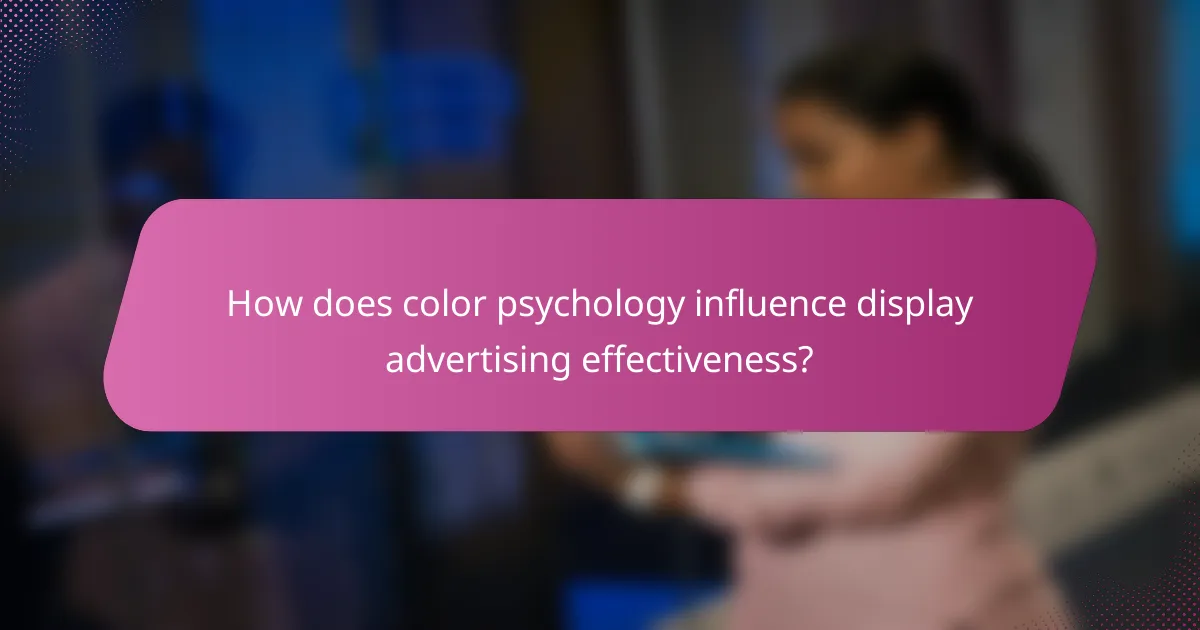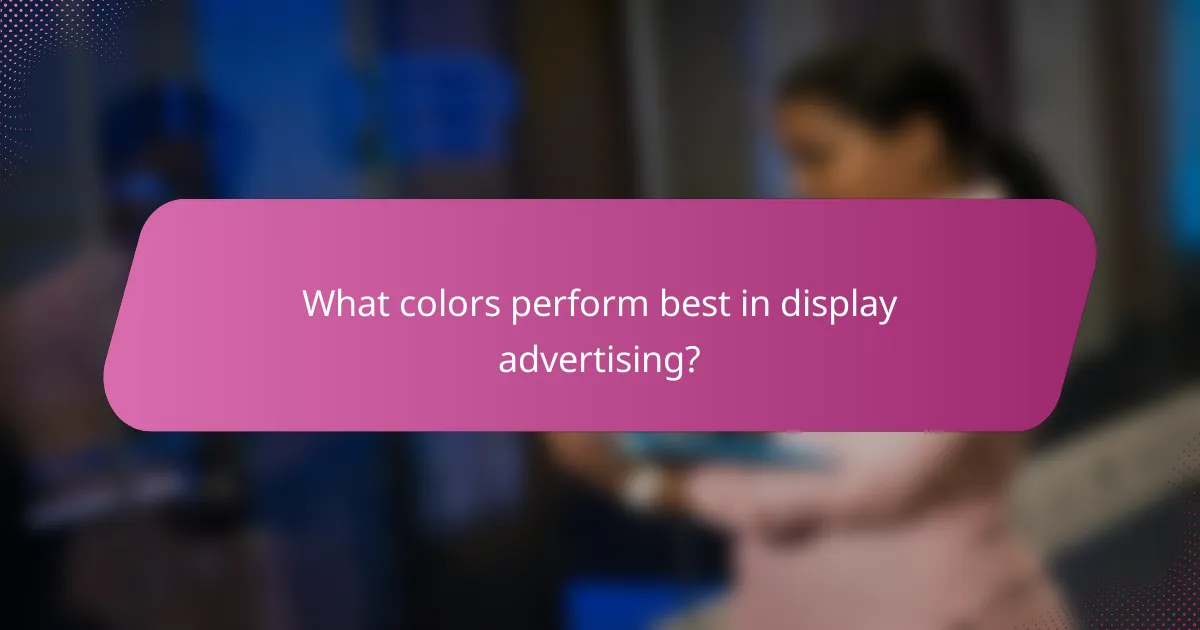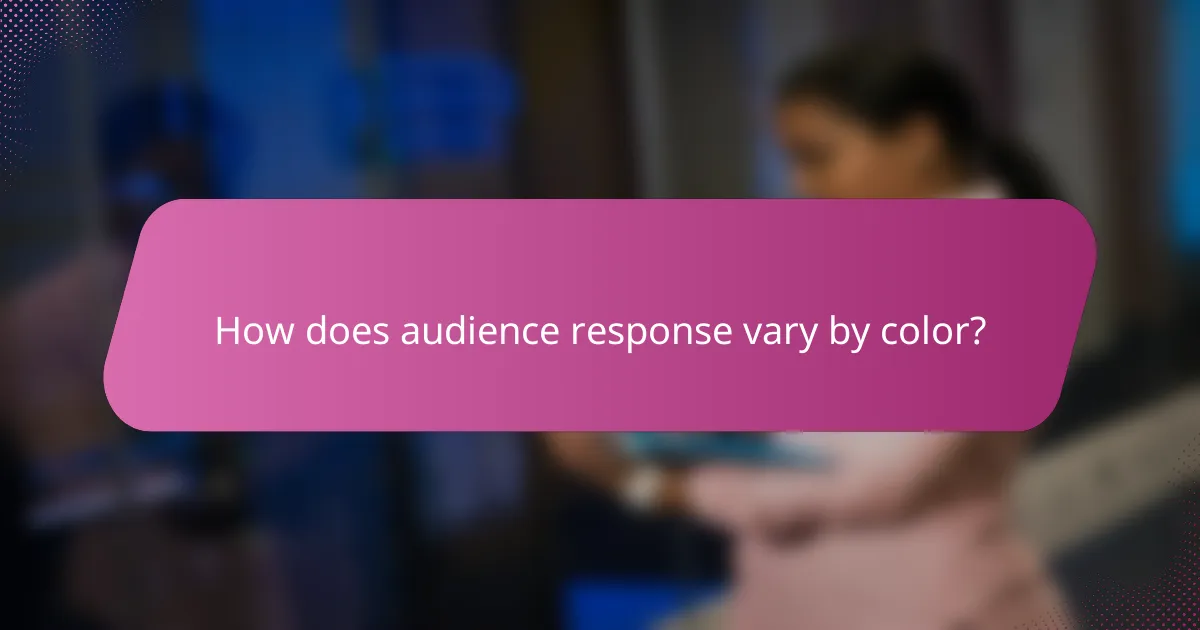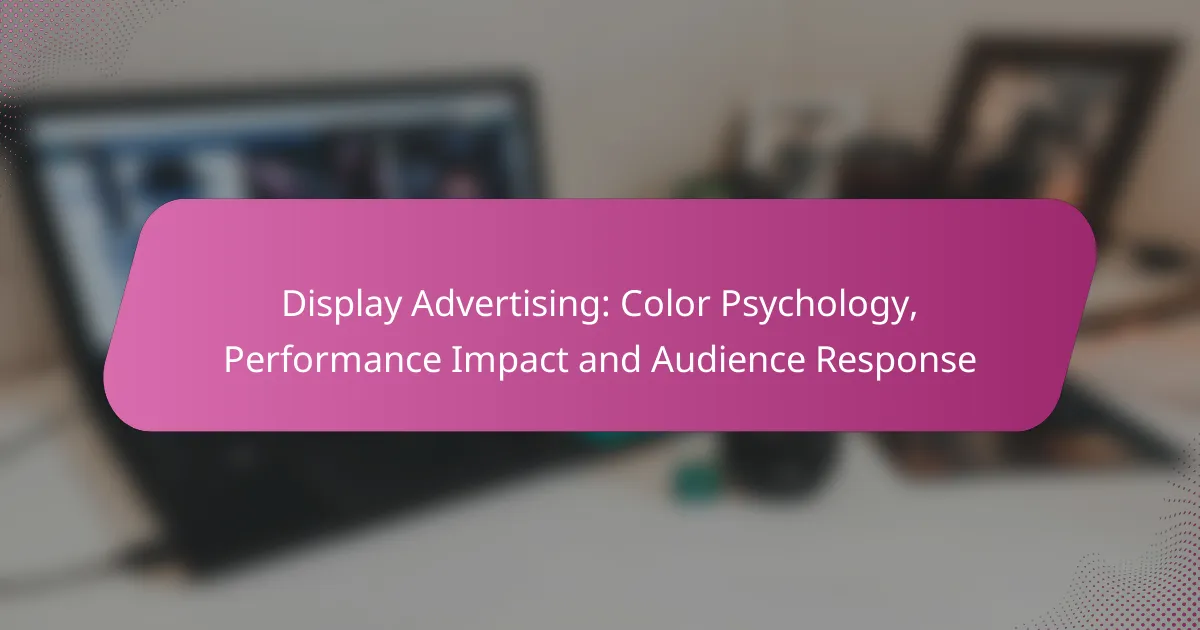Color psychology plays a crucial role in the effectiveness of display advertising by shaping consumer emotions and behaviors. By strategically choosing colors, advertisers can enhance brand recognition, boost engagement, and increase conversion rates. The success of color choices often hinges on the target audience and campaign objectives, with certain colors like blue, green, and orange generally yielding better performance. Understanding the emotional impact of colors can significantly improve the overall effectiveness of advertising campaigns.

How does color psychology influence display advertising effectiveness?
Color psychology significantly impacts display advertising effectiveness by evoking emotions and influencing consumer behavior. The right color choices can enhance brand recognition, improve engagement, and ultimately drive conversions.
Emotional responses to colors
Different colors evoke distinct emotional responses, which can affect how consumers perceive an advertisement. For instance, blue often conveys trust and calmness, making it popular in finance and healthcare sectors, while red can create a sense of urgency and excitement, frequently used in sales promotions.
Understanding these emotional triggers allows advertisers to align their color schemes with the desired response from their target audience, enhancing the overall effectiveness of their campaigns.
Color associations with brands
Colors can create strong associations with specific brands, influencing consumer loyalty and recognition. For example, green is commonly linked to eco-friendliness and health, making it a staple for brands in the organic and sustainable markets.
Consistent use of color in branding helps establish a visual identity, making it easier for consumers to remember and identify the brand in a crowded marketplace.
Impact on click-through rates
Color choices can significantly affect click-through rates (CTR) in display advertising. Studies suggest that ads with contrasting colors can increase visibility and engagement, leading to higher CTRs. For instance, a bright call-to-action button against a muted background can draw attention and encourage clicks.
Advertisers should test different color combinations to determine which ones yield the best performance for their specific audience and objectives.
Case studies from major brands
Major brands have successfully leveraged color psychology to enhance their advertising effectiveness. For example, Coca-Cola’s use of red is synonymous with its brand identity, creating a sense of excitement and energy that resonates with consumers.
Another example is the use of blue by Facebook, which promotes feelings of trust and security, essential for a platform that handles personal information. These case studies illustrate the importance of strategic color choices in achieving marketing goals.

What colors perform best in display advertising?
The colors that perform best in display advertising often depend on the target audience and the specific goals of the campaign. Generally, colors like blue, green, and orange are known to drive higher engagement and conversions, but the effectiveness can vary based on context and demographic factors.
High-performing colors for conversions
Colors such as blue are often associated with trust and reliability, making them effective for brands aiming to establish credibility. Green is frequently linked to growth and health, appealing to audiences interested in sustainability or wellness. Orange, on the other hand, tends to evoke feelings of excitement and urgency, which can prompt quicker consumer action.
When designing display ads, consider using contrasting colors to make calls to action stand out. For example, a bright orange button on a blue background can attract attention and enhance click-through rates.
Color preferences by demographic
Demographic factors such as age, gender, and cultural background significantly influence color preferences. For instance, younger audiences may gravitate towards vibrant colors, while older demographics might prefer more muted tones. Additionally, women often respond positively to softer colors like pastels, whereas men may favor bolder shades.
Understanding these preferences can guide your color choices in display advertising, ensuring that your ads resonate with the intended audience. Conducting A/B testing with different color schemes can provide insights into what works best for your specific demographic.
Industry-specific color trends
Different industries tend to favor specific colors that align with their branding and consumer expectations. For example, the tech industry often uses blue to convey innovation and reliability, while the food industry frequently employs warm colors like red and yellow to stimulate appetite.
In the finance sector, green is commonly used to represent wealth and stability, while healthcare brands may opt for calming colors like blue and green to promote a sense of safety. Analyzing competitors in your industry can help you identify effective color trends that can enhance your display advertising efforts.

How can advertisers leverage color psychology?
Advertisers can leverage color psychology by selecting colors that evoke specific emotions and behaviors in their target audience. Understanding how different colors influence perception can enhance brand recognition and improve campaign effectiveness.
Color selection strategies
Choosing the right colors involves understanding the psychological impact of each hue. For instance, blue often conveys trust and reliability, making it popular among financial institutions, while red can evoke urgency and excitement, suitable for clearance sales. Consider your brand identity and the emotions you want to elicit when selecting colors.
Additionally, cultural context plays a significant role in color perception. For example, while white symbolizes purity in many Western cultures, it can represent mourning in some Eastern cultures. Tailoring your color choices to your audience’s cultural background can enhance engagement.
Testing color variations in campaigns
Testing different color variations is crucial for optimizing ad performance. A/B testing allows advertisers to compare two or more color schemes to determine which resonates best with the audience. For example, a simple change from a blue button to a green one can lead to noticeable differences in click-through rates.
When conducting tests, ensure you have a sufficient sample size to achieve statistically significant results. Monitor key metrics such as conversion rates and user engagement to assess the impact of color changes effectively.
Tools for color analysis
Several tools can assist in color analysis, helping advertisers make informed decisions. Tools like Adobe Color and Coolors allow users to create color palettes and visualize how colors work together. These platforms can help ensure that color choices align with brand guidelines and psychological objectives.
Additionally, analytics platforms like Google Analytics can provide insights into user behavior related to color variations in ads. By integrating these tools, advertisers can refine their strategies based on real-time data and audience feedback.

What are the key performance metrics for display ads?
The key performance metrics for display ads include click-through rate (CTR), conversion rate analysis, and return on ad spend (ROAS). These metrics help advertisers assess the effectiveness of their campaigns and make informed decisions to optimize performance.
Click-through rate (CTR)
Click-through rate (CTR) measures the percentage of users who click on a display ad after seeing it. A higher CTR indicates that the ad is engaging and relevant to the audience. Typically, a good CTR for display ads ranges from 0.5% to 2%, depending on the industry and ad placement.
To improve CTR, focus on creating eye-catching visuals and compelling calls to action. Testing different ad formats and placements can also help identify what resonates best with your target audience.
Conversion rate analysis
Conversion rate analysis evaluates the percentage of users who complete a desired action after clicking on a display ad, such as making a purchase or signing up for a newsletter. A strong conversion rate generally falls between 2% and 5%, but this can vary significantly based on the product and market.
To enhance conversion rates, ensure that the landing page aligns with the ad’s message and provides a seamless user experience. A/B testing different landing pages can reveal which elements drive higher conversions.
Return on ad spend (ROAS)
Return on ad spend (ROAS) measures the revenue generated for every dollar spent on advertising. A ROAS of 4:1, meaning four dollars earned for every dollar spent, is often considered a benchmark for success. However, acceptable ROAS can differ across industries and campaign goals.
To maximize ROAS, continuously monitor ad performance and adjust targeting, creative, and bidding strategies. Analyzing customer lifetime value can also inform how much to invest in acquiring new customers through display ads.

How does audience response vary by color?
Audience response to color in advertising can significantly influence engagement and conversion rates. Different colors evoke distinct emotions and associations, which can affect how potential customers perceive a brand and its messaging.
Audience segmentation by color preference
Understanding audience segmentation by color preference is crucial for effective advertising. Different demographics may respond uniquely to specific colors; for instance, younger audiences often prefer vibrant colors, while older consumers may favor muted tones. Tailoring color choices to align with the preferences of target segments can enhance resonance and engagement.
Conducting surveys or using analytics tools can help identify the color preferences of your audience, allowing for more strategic color selection in campaigns.
Behavioral insights from color usage
Behavioral insights reveal that colors can trigger specific psychological responses, influencing consumer behavior. For example, blue often conveys trust and reliability, making it popular among financial institutions, while red can create urgency, commonly used in clearance sales. Understanding these associations can guide the selection of colors that align with desired consumer actions.
Testing different color schemes through A/B testing can provide valuable data on how color impacts click-through rates and conversions, enabling advertisers to optimize their designs effectively.
Regional color preferences in advertising
Regional color preferences can vary widely, influenced by cultural meanings and associations. For instance, while white is often associated with purity in Western cultures, it can symbolize mourning in some Eastern cultures. Advertisers should consider these cultural contexts when designing campaigns for different regions.
Researching local color symbolism and preferences can help brands avoid missteps and enhance their appeal in diverse markets. Utilizing local insights ensures that color choices resonate positively with the target audience, ultimately improving campaign effectiveness.

What frameworks help in selecting color strategies?
Frameworks for selecting color strategies in display advertising include the Color Wheel, Color Harmony, and the Psychology of Color. These frameworks guide marketers in choosing colors that resonate with their target audience and enhance ad performance.
Color Wheel
The Color Wheel is a visual representation of colors arranged according to their chromatic relationship. It helps advertisers identify complementary, analogous, and triadic color schemes, which can evoke specific emotions and reactions from viewers. For example, using complementary colors can create a vibrant look that draws attention.
Color Harmony
Color Harmony refers to the aesthetically pleasing arrangement of colors that create a sense of balance and unity. Marketers should consider using harmonious color combinations to foster positive audience responses. For instance, a palette of soft pastels may convey calmness, while bold primary colors can evoke excitement.
Psychology of Color
The Psychology of Color examines how different colors influence human behavior and emotions. Understanding this can help advertisers tailor their color choices to align with their brand message. For example, blue often conveys trust and reliability, making it a popular choice for financial services, while red can stimulate urgency and action, ideal for sales promotions.



